Book contents
- Frontmatter
- Contents
- List of figures
- List of tables
- List of contributors
- Foreword
- Preface and acknowledgments
- List of abbreviations
- 1 Introduction
- 2 Multilingualism: The global approach to sign languages
- 3 Bilingualism and language contact
- 4 Sociolinguistic variation
- 5 Discourse analysis
- 6 Language planning and policy
- 7 Language attitudes
- Bibliography
- Index
3 - Bilingualism and language contact
Published online by Cambridge University Press: 24 November 2009
- Frontmatter
- Contents
- List of figures
- List of tables
- List of contributors
- Foreword
- Preface and acknowledgments
- List of abbreviations
- 1 Introduction
- 2 Multilingualism: The global approach to sign languages
- 3 Bilingualism and language contact
- 4 Sociolinguistic variation
- 5 Discourse analysis
- 6 Language planning and policy
- 7 Language attitudes
- Bibliography
- Index
Summary
… People say our signs [in Singapore] come from Australia, China and America. So I am worried that [this means that] we do not have our own sign language … Also, why are there so many signs for the same thing? Which is the right sign? … Why can't everyone just sign the right way?
Excerpted from a fax to the author from a Singaporean deaf person, 1994It is probably true that no language group has ever existed in isolation from other language groups, and the history of languages is replete with examples of language contact leading to some form of bilingualism.
François Grosjean, Life with Two Languages (1982: 1)Spoken languages have always been in contact with each other, and there have always been linguistic and sociolinguistic consequences of this phenomenon. Languages come into contact through their speakers, who are brought together under different sorts of conditions, including political turmoil, immigration, education and geography. Indeed, languages are sometimes said to be “in contact” within bilingual individuals (Grosjean, 1992: 309). The immense and engaging field of the study of language contact points up interesting linguistic situations. For example, examination of the current position of English in the world confirms that English is an extremely prestigious language that is learned as a second language with great frequency. It is the world's lingua franca; that is, it is the language chosen by speakers of diverse languages in the hearing world for many sorts of needs, from science and technology to business and scholarship.
- Type
- Chapter
- Information
- The Sociolinguistics of Sign Languages , pp. 33 - 60Publisher: Cambridge University PressPrint publication year: 2001
- 16
- Cited by



